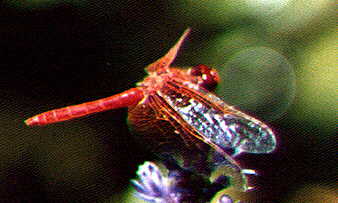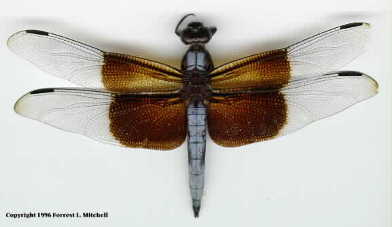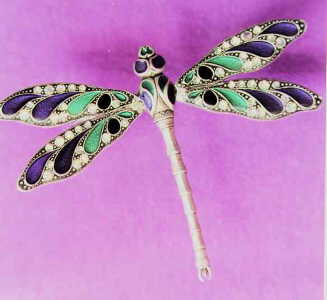Pond Jewelry
Kathy (at
bigsnest@sonic.net)
|

Another colorful jewel, common across the USA west of Kansas, is the Flame Skimmer (Libellula saturata). It is also featured on my Jewelry title by Stevem. At 2½ inches, with an orange-red body, head and eyes, its activity around the pond adds zest to any site. A similar dragonfly, the Neon Skimmer has red on the wings also, but only near the body, not out to the slight bend in the wing (nodus). This photo is from Ron Lyons at Checklist of Odonata of California. Last February, Ron wrote a great article about dragonflies and their lives for the IPS "Critters" column. Read his DAMSELS AND DRAGONS -THE INSECT ORDER ODONATA to learn A LOT more about their fascinating lives. |

The Blue Dasher (Pachydiplax longipennis) is just about my favorite dragonfly. They are about 2 inches long with a wingspan of 3 inches. The males stake out a territory at our pond and then spend many hours chasing away anything blue that comes along! . . . even if the blue thing is my son's baseball cap! This cutie's picture is from Blair Nikula's Ode News site in Cape Cod. Blair has over 100 photos of Odonata (the scientific name for dragonflies and damselflies) on his site! He also has links to many other dragonfly sites and has just about the best collection of damselfly pictures I've found anywhere. Damselflies are the smaller, weaker cousins of the dragonflies, with slender bodies. Maybe I'll do an article on them some time soon if there is any interest. Let me know! |
|
Colorful wings are the hallmark of the Twelve-spotted Skimmer (Libellula pulchella). There are other "spot-winged" dragonflies also. To determine if yours is a 4, 8, or 12 spot, count the black spots on one wing and multiply by 4. The Twelve-spotted occurs throughout most of the USA and is a little over 2 inches long with a wingspan of just over 3 inches. This skimmer likes to rest on lily pads or other plants overhanging the water. Stuart Tingley took this photo and has it on his Dragonflies and Damselflies of New Brunswick website. |
|
|
|
|
|
|
 Well, I'd love to show you more but I have to stop at some point,
so just because I haven't included a Yellow Jewel yet, here one is:
this female Saffron-winged Meadowhawk (Sympetrum
costiferum) by Blair Nikula from his
Massachusetts
site is the most brilliant color! Well, I'd love to show you more but I have to stop at some point,
so just because I haven't included a Yellow Jewel yet, here one is:
this female Saffron-winged Meadowhawk (Sympetrum
costiferum) by Blair Nikula from his
Massachusetts
site is the most brilliant color! |
|
I hope you've enjoyed looking at these pieces of Pond Jewelry and that the article has helped you to appreciate those at your pond. I should mention that Dragonflies have only recently been given Common Names that are recognized everywhere, so if you look at a book and the common name is different, it just means that the book was written before August of 1996! A few very helpful websites I have not yet provided links to in this article are listed below.
Bob Barker's Odonatology Home Page Mark O'Brien's Odonata Photo Archive
Happy web-surfing! Happy Summer! And remember to treat you pond as a valuable habitat for wetland species. Here's a piece of REAL pond dragonfly jewelry!
|


 The darners, like all other dragonflies, spend most of their lives as nymphs in
our ponds and only a short time as dragons on wings.
The darners, like all other dragonflies, spend most of their lives as nymphs in
our ponds and only a short time as dragons on wings.

 The Cardinal Meadowhawk (Sympetrum illotum) pictured
here from my
The Cardinal Meadowhawk (Sympetrum illotum) pictured
here from my
 This is a
scanned real live dragonfly from Forrest Mitchell's
This is a
scanned real live dragonfly from Forrest Mitchell's  This Four-spotted Skimmer (Libellula quadrimaculata) ranges from
Labrador to Arizona and north to Alaska! At a little over 2 inches, it is not
quite as large as some of the others. This photo is provided by Dennis
Paulson at his
This Four-spotted Skimmer (Libellula quadrimaculata) ranges from
Labrador to Arizona and north to Alaska! At a little over 2 inches, it is not
quite as large as some of the others. This photo is provided by Dennis
Paulson at his 